
The Ferrymead Railway is a New Zealand heritage railway built upon the track formation of New Zealand's first public railway, from Ferrymead to Christchurch, which opened on 1 December 1863. On the opening of the line to Lyttelton on 9 December 1867, the Ferrymead Railway became the Ferrymead Branch and was closed shortly thereafter. In 1964, rail enthusiasts began relaying track on the historic formation and the new 3 ft 6 in narrow gauge. Ferrymead Railway officially reopened in 1977. It now operates steam, diesel and electric trains regularly and is recognised as one of the most significant rail preservation sites in New Zealand.
The Canterbury Railway Society is an organisation of railway enthusiasts based in the Canterbury region of New Zealand's South Island, best known for their operation of The Ferrymead Railway at the Ferrymead Heritage Park.

Rail transport in New Zealand is an integral part of New Zealand's transport network, with a nationwide network of 4,375.5 km (2,718.8 mi) of track linking most major cities in the North and South Islands, connected by inter-island rail and road ferries. Rail transport in New Zealand has a particular focus on bulk freight exports and imports, with 19 million net tonnes moved by rail annually, accounting for more than half of rail revenue.

The New Zealand F class was the first important class of steam locomotive built to operate on New Zealand's railway network after the national gauge of 3 ft 6 in was adopted. The first locomotives built for the new gauge railways were two E class double Fairlies for the Dunedin and Port Chalmers Railway Company. The F class was the first class ordered by the central government, and between 1872 and 1888, a total of eighty-eight members of the class were constructed.

The NZR A class of 1873 consisted of three types of steam locomotives used on New Zealand's railway network of similar specification but differing detail. The first and most numerous were from the Dübs and Company, the next from the Wellington firm E.W. Mills Lion Foundry, and the last from the Scottish firm of Shanks. The specifications are for the Dubs Yorkshire engines.
Locomotives of New Zealand is a complete list of all locomotive classes that operate or have operated in New Zealand's railway network. It does not include locomotives used on bush tramways.

The NZR WD class was a class of tank locomotive built by Baldwin Locomotive Works to operate on New Zealand's national rail network.
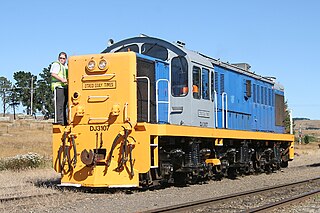
The New Zealand DJ class locomotive is a type of diesel-electric locomotive in service on the New Zealand rail network. The class were built by Mitsubishi Heavy Industries and introduced from 1968 to 1969 for the New Zealand Railways Department (NZR) with a modernisation loan from the World Bank to replace steam locomotives in the South Island, where all of the class members worked most of their lives. Nine of the locomotives remain in use, mainly with Dunedin Railways.
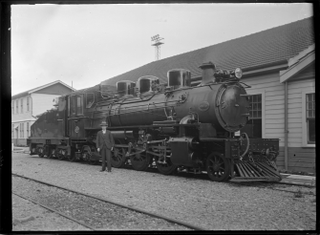
The NZR C class consisted of twenty-four steam locomotives built to perform shunting duties on New Zealand's national rail network. It is sometimes known as the big C class to differentiate it from the C class of 1873.

The NZR WAB class locomotives were steam locomotives designed, built and used by New Zealand Railways Department (NZR). Their wheel arrangement is described by the Whyte notation 4-6-4T. The locomotives were designed by NZR chief draughtsman S.H. Jenkinson as tank versions of the AB class 4-6-2 Pacific locomotive. Initially, the locomotives were separated into two classes, designated WAB for mainline work and WS for suburban work.
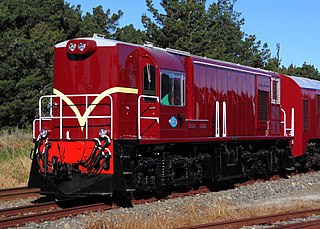
The New Zealand DI class locomotive was a class of diesel-electric locomotive in New Zealand. They were built by English Electric at their plant in Rocklea, Queensland in Australia. The class is very similar to the Queensland Railways 1620 class locomotives. At the time of their introduction, the class was seen as an alternative to the DB class for use on lightly laid secondary and branch lines, more so in the South Island. The World Bank financed introduction of the Japanese built DJ class in 1968, which ensured that no further DI class locomotives were purchased by New Zealand Railways.
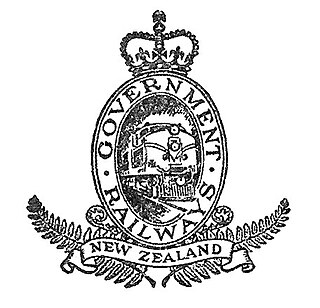
The New Zealand Railways Department, NZR or NZGR and often known as the "Railways", was a government department charged with owning and maintaining New Zealand's railway infrastructure and operating the railway system. The Department was created in 1880 and was corporatised on 1 April 1982 into the New Zealand Railways Corporation. Originally, railway construction and operation took place under the auspices of the former provincial governments and some private railways, before all of the provincial operations came under the central Public Works Department. The role of operating the rail network was subsequently separated from that of the network's construction. From 1895 to 1993 there was a responsible Minister, the Minister of Railways. He was often also the Minister of Public Works.

The New Zealand DG and DH class were classes of forty-two diesel-electric locomotives operated on New Zealand's rail network between 1955 and 1983.

The New Zealand DE class was a class of fifteen diesel-electric shunting locomotives, introduced by the New Zealand Railways (NZR) with an intention to replace steam locomotives on shunting duties with diesel power. The class was physically similar to the Tasmanian Government Railways X class, which was also of English Electric design.
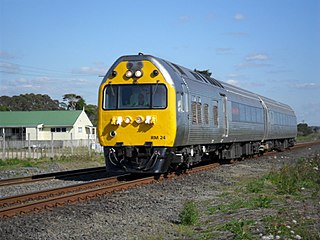
The RM class was the classification used by the New Zealand Railways Department (NZR) and its successors gave to most railcars and railbuses that have operated on New Zealand's national rail network. "RM" stands for Rail Motor which was the common name at the turn of the 20th century for what became known in New Zealand as railcars. As many types of railcars are operated, class names have been given to each railcar type to differentiate them from others.

Steam Incorporated, often abbreviated to Steam Inc., is a railway heritage and preservation society based at the Paekākāriki railway station, Paekākāriki at the southern end of the Kāpiti Coast, approximately 50 minutes north of Wellington on the west coast of New Zealand's North Island. Unlike some societies who operate on preserved sections of closed branch lines, Steam Incorporated owns a depot beside one of the country's most important railway lines, the North Island Main Trunk railway, and restores heritage locomotives and rolling stock for use on excursions on the regular national rail network.

A & G Price Limited is an engineering firm and locomotive manufacturer in Thames, New Zealand founded in 1868.
The Diesel Traction Group (DTG) is the Christchurch-based operator of a fleet of ex-New Zealand Railways Department diesel-electric locomotives. The fleet represents a full collection of New Zealand locomotive classes built by the English Electric Company and is a historically significant collection of early New Zealand diesel traction. All of the DTG's locomotives are owned by individual members through the sale of shareholdings.
The NZR DS class locomotive is a type of 16 diesel shunting locomotives built by the Vulcan Foundry and supplied by the Drewry Car Co from 1949–1955, for New Zealand Railways (NZR).
















